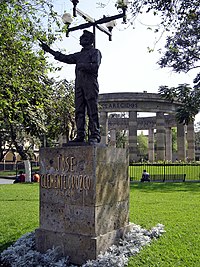José Orozco
| José Clemente Orozco | |
|---|---|

José Clemente Orozco in the Rotunda of Illustrious, Guadalajara, Jalisco
|
|
| Born |
November 23, 1883 Ciudad Guzmán, Mexico |
| Died | September 7, 1949 (aged 65) Mexico City, Mexico |
| Nationality | Mexican |
| Education | San Carlos Academy |
| Known for | Painting, Muralist |
| Movement | Mexican Mural Movement, Social Realism |
| Awards | National Prize for Arts and Sciences |
José Clemente Orozco (November 23, 1883 – September 7, 1949) was a Mexican painter, who specialized in political murals that established the Mexican Mural Renaissance together with murals by Diego Rivera, David Alfaro Siqueiros, and others. Orozco was the most complex of the Mexican muralists, fond of the theme of human suffering, but less realistic and more fascinated by machines than Rivera. Mostly influenced by Symbolism, he was also a genre painter and lithographer. Between 1922 and 1948, Orozco painted murals in Mexico City, Orizaba, Claremont, California, New York City, Hanover, New Hampshire, Guadalajara, Jalisco, and Jiquilpan, Michoacán. His drawings and paintings are exhibited by the Carrillo Gil Museum in Mexico City, and the Orozco Workshop-Museum in Guadalajara. Orozco was known for being a politically committed artist and promoted the political causes of peasants and workers.
José Clemente Orozco was born in 1883 in Zapotlán el Grande (now Ciudad Guzmán), Jalisco to Rosa de Flores Orozco. He married Margarita Valladares, and had three children. At the age of 21, Orozco lost his left hand while working with gunpowder to make fireworks.
The satirical illustrator José Guadalupe Posada, whose engravings about Mexican culture and politics challenged Mexicans to think differently about post-revolutionary Mexico, worked in full view of the public in shop windows located on the way Orozco went to school. In his autobiography, Orozco confesses, "I would stop [on my way to and from school] and spend a few enchanted minutes in watching [Posada]… This was the push that first set my imagination in motion and impelled me to cover paper with my earliest little figures; this was my awakening to the existence of the art of painting" (Orozco, 1962). He goes on to say that watching Posada's engraving decorated gave him his introduction to the use of color. After attending school for Agriculture and Architecture, Orozco studied art at the Academy of San Carlos. He worked as an illustrator for Mexico City newspapers and directly as an illustrator for one of the Constitutionalist armies overseen by "First Chief" Venustiano Carranza. When the revolutionary factions split in 1914 after Victoriano Huerta was ousted, Orozco supported Carranza and General Álvaro Obregón against Pancho Villa and Emiliano Zapata.
...
Wikipedia
